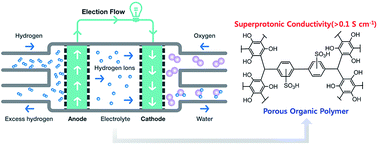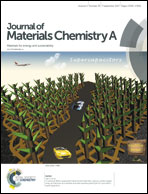A conductive porous organic polymer with superprotonic conductivity of a Nafion-type electrolyte†
Abstract
As potential solid electrolytes in fuel cells, porous organic polymers show compelling proton conductivities (up to ∼10−2 S cm−1), but even higher performance is required for real applications. In this work, we prepared a biphenyl-based organic polymeric framework of 1E with a larger surface area as an extended version of a phenyl-based polymer. The construction of the framework from C–C covalent bonds allows exceptional stability to be realized under the operating conditions of fuel cells. Successful post-synthetic modification of 1E afforded the sulfonated material 1ES. Notably, the conductivity of 1ES was ∼104 orders of magnitude greater than that of 1E at 30 °C and 90% relative humidity (RH). The conductivity of 1ES reached 1.59 × 10−1 S cm−1 at 80 °C and 90% RH, which is superior to those observed for any porous organic polymer conductors reported so far and even surpasses that of Nafion. This polymer, simply prepared and scalable for mass production, was stable at 80 °C and 90% RH for more than 4 months without conductivity loss.



 Please wait while we load your content...
Please wait while we load your content...